Managing Successful Business Project: CSR Implementation at Qbic Hotel
VerifiedAdded on 2020/06/04
|25
|4629
|47
Report
AI Summary
This report provides a comprehensive analysis of Corporate Social Responsibility (CSR) implementation within Qbic Hotel, London UK, focusing on how CSR activities contribute to sustainable business objectives. The report begins with an introduction outlining the aims, objectives, and research questions, followed by a detailed project management plan, including a Gantt chart and work breakdown structure. It then delves into the research methodology, including qualitative research, deductive approach, and thematic analysis, used to gather and analyze data from a sample of 20 employees. The analysis section presents the findings, including statistical data and interpretations of the responses. The report concludes with recommendations for effective CSR implementation, a self-reflection, and relevant references, providing a thorough examination of the role and impact of CSR in the hospitality sector. The study also addresses limitations such as time and resource constraints.
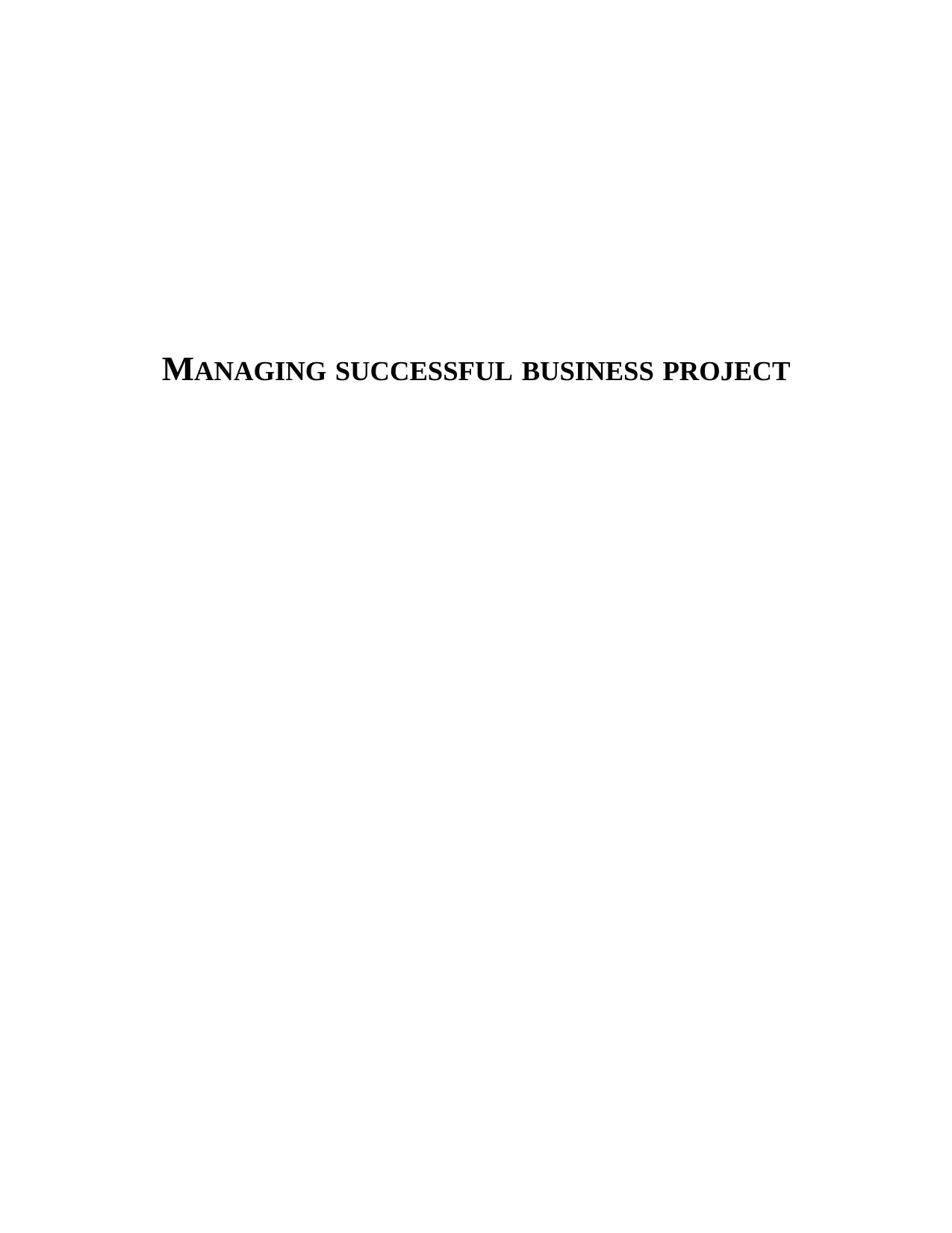
MANAGING SUCCESSFUL BUSINESS PROJECT
Paraphrase This Document
Need a fresh take? Get an instant paraphrase of this document with our AI Paraphraser
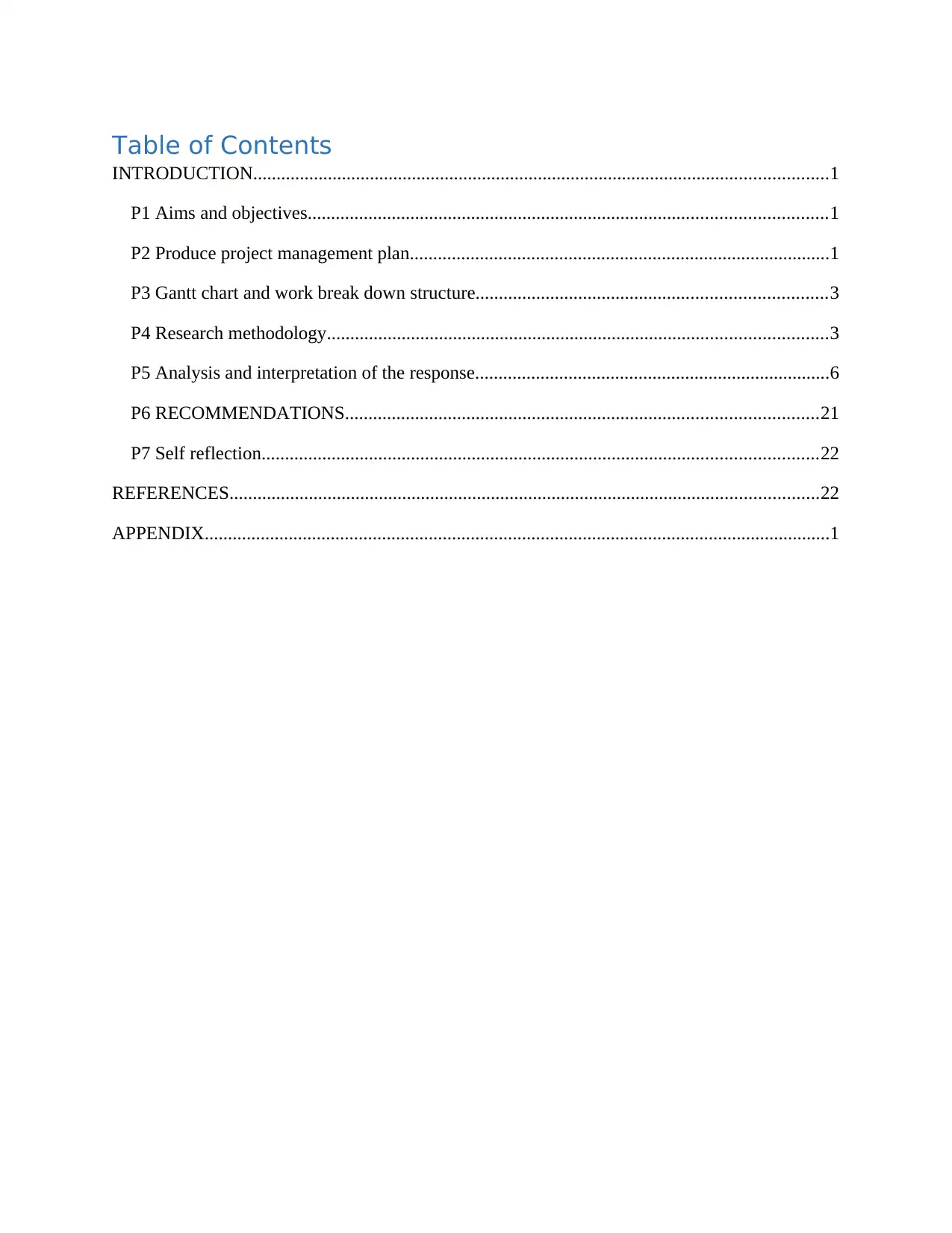
Table of Contents
INTRODUCTION...........................................................................................................................1
P1 Aims and objectives...............................................................................................................1
P2 Produce project management plan..........................................................................................1
P3 Gantt chart and work break down structure...........................................................................3
P4 Research methodology...........................................................................................................3
P5 Analysis and interpretation of the response............................................................................6
P6 RECOMMENDATIONS.....................................................................................................21
P7 Self reflection.......................................................................................................................22
REFERENCES..............................................................................................................................22
APPENDIX......................................................................................................................................1
INTRODUCTION...........................................................................................................................1
P1 Aims and objectives...............................................................................................................1
P2 Produce project management plan..........................................................................................1
P3 Gantt chart and work break down structure...........................................................................3
P4 Research methodology...........................................................................................................3
P5 Analysis and interpretation of the response............................................................................6
P6 RECOMMENDATIONS.....................................................................................................21
P7 Self reflection.......................................................................................................................22
REFERENCES..............................................................................................................................22
APPENDIX......................................................................................................................................1
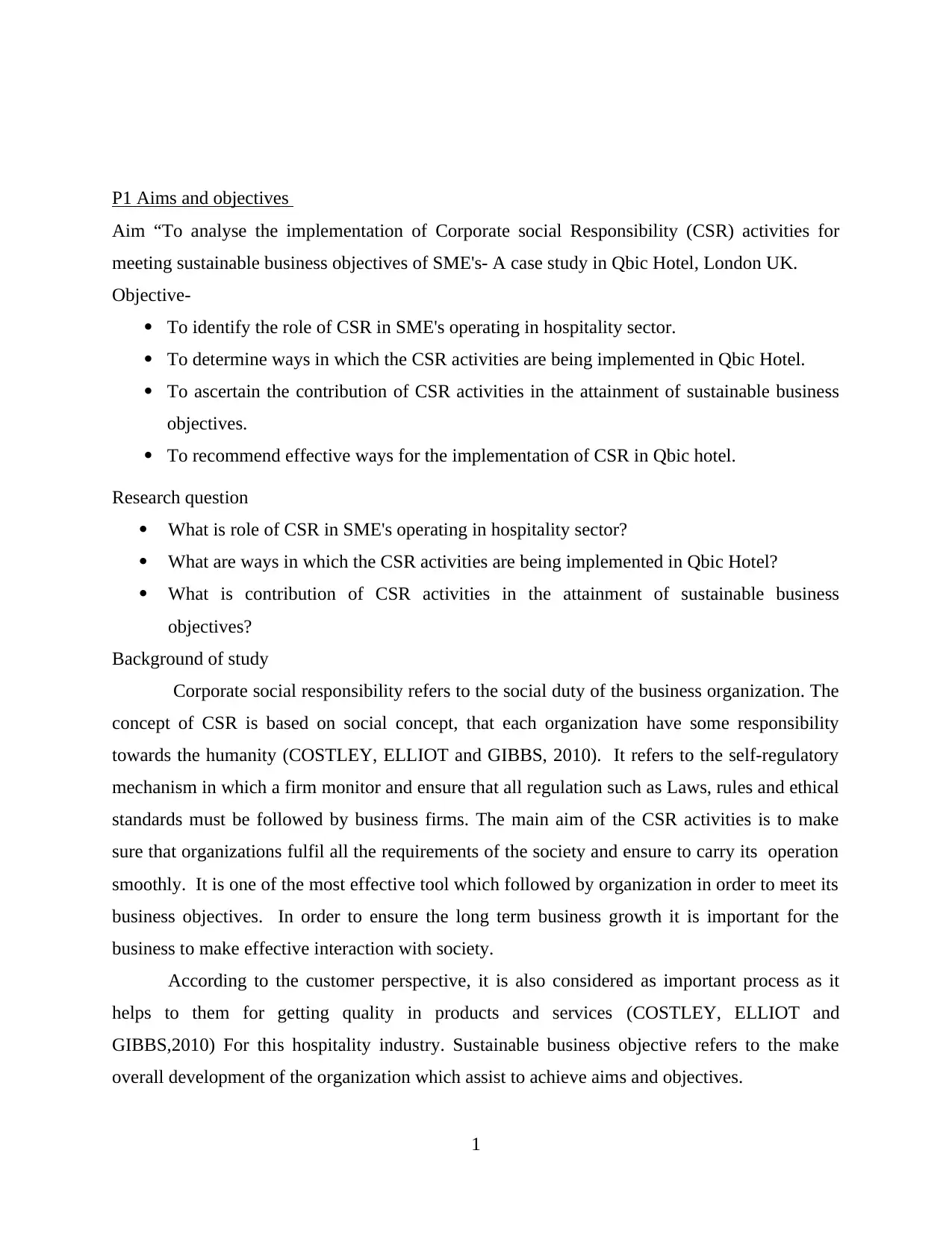
P1 Aims and objectives
Aim “To analyse the implementation of Corporate social Responsibility (CSR) activities for
meeting sustainable business objectives of SME's- A case study in Qbic Hotel, London UK.
Objective-
To identify the role of CSR in SME's operating in hospitality sector.
To determine ways in which the CSR activities are being implemented in Qbic Hotel.
To ascertain the contribution of CSR activities in the attainment of sustainable business
objectives.
To recommend effective ways for the implementation of CSR in Qbic hotel.
Research question
What is role of CSR in SME's operating in hospitality sector?
What are ways in which the CSR activities are being implemented in Qbic Hotel?
What is contribution of CSR activities in the attainment of sustainable business
objectives?
Background of study
Corporate social responsibility refers to the social duty of the business organization. The
concept of CSR is based on social concept, that each organization have some responsibility
towards the humanity (COSTLEY, ELLIOT and GIBBS, 2010). It refers to the self-regulatory
mechanism in which a firm monitor and ensure that all regulation such as Laws, rules and ethical
standards must be followed by business firms. The main aim of the CSR activities is to make
sure that organizations fulfil all the requirements of the society and ensure to carry its operation
smoothly. It is one of the most effective tool which followed by organization in order to meet its
business objectives. In order to ensure the long term business growth it is important for the
business to make effective interaction with society.
According to the customer perspective, it is also considered as important process as it
helps to them for getting quality in products and services (COSTLEY, ELLIOT and
GIBBS,2010) For this hospitality industry. Sustainable business objective refers to the make
overall development of the organization which assist to achieve aims and objectives.
1
Aim “To analyse the implementation of Corporate social Responsibility (CSR) activities for
meeting sustainable business objectives of SME's- A case study in Qbic Hotel, London UK.
Objective-
To identify the role of CSR in SME's operating in hospitality sector.
To determine ways in which the CSR activities are being implemented in Qbic Hotel.
To ascertain the contribution of CSR activities in the attainment of sustainable business
objectives.
To recommend effective ways for the implementation of CSR in Qbic hotel.
Research question
What is role of CSR in SME's operating in hospitality sector?
What are ways in which the CSR activities are being implemented in Qbic Hotel?
What is contribution of CSR activities in the attainment of sustainable business
objectives?
Background of study
Corporate social responsibility refers to the social duty of the business organization. The
concept of CSR is based on social concept, that each organization have some responsibility
towards the humanity (COSTLEY, ELLIOT and GIBBS, 2010). It refers to the self-regulatory
mechanism in which a firm monitor and ensure that all regulation such as Laws, rules and ethical
standards must be followed by business firms. The main aim of the CSR activities is to make
sure that organizations fulfil all the requirements of the society and ensure to carry its operation
smoothly. It is one of the most effective tool which followed by organization in order to meet its
business objectives. In order to ensure the long term business growth it is important for the
business to make effective interaction with society.
According to the customer perspective, it is also considered as important process as it
helps to them for getting quality in products and services (COSTLEY, ELLIOT and
GIBBS,2010) For this hospitality industry. Sustainable business objective refers to the make
overall development of the organization which assist to achieve aims and objectives.
1
⊘ This is a preview!⊘
Do you want full access?
Subscribe today to unlock all pages.

Trusted by 1+ million students worldwide
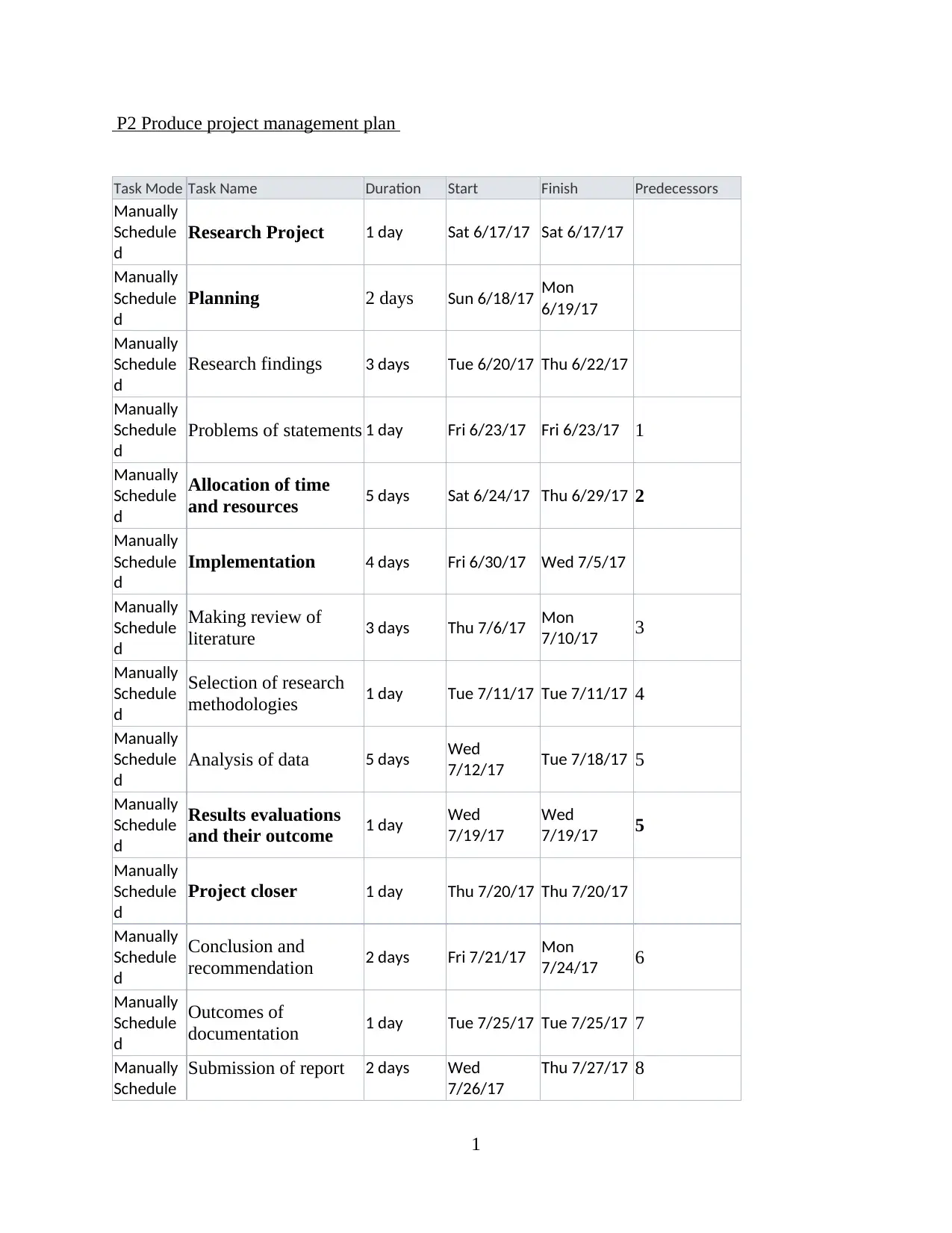
P2 Produce project management plan
Task Mode Task Name Duration Start Finish Predecessors
Manually
Schedule
d
Research Project 1 day Sat 6/17/17 Sat 6/17/17
Manually
Schedule
d
Planning 2 days Sun 6/18/17 Mon
6/19/17
Manually
Schedule
d
Research findings 3 days Tue 6/20/17 Thu 6/22/17
Manually
Schedule
d
Problems of statements 1 day Fri 6/23/17 Fri 6/23/17 1
Manually
Schedule
d
Allocation of time
and resources 5 days Sat 6/24/17 Thu 6/29/17 2
Manually
Schedule
d
Implementation 4 days Fri 6/30/17 Wed 7/5/17
Manually
Schedule
d
Making review of
literature 3 days Thu 7/6/17 Mon
7/10/17 3
Manually
Schedule
d
Selection of research
methodologies 1 day Tue 7/11/17 Tue 7/11/17 4
Manually
Schedule
d
Analysis of data 5 days Wed
7/12/17 Tue 7/18/17 5
Manually
Schedule
d
Results evaluations
and their outcome 1 day Wed
7/19/17
Wed
7/19/17 5
Manually
Schedule
d
Project closer 1 day Thu 7/20/17 Thu 7/20/17
Manually
Schedule
d
Conclusion and
recommendation 2 days Fri 7/21/17 Mon
7/24/17 6
Manually
Schedule
d
Outcomes of
documentation 1 day Tue 7/25/17 Tue 7/25/17 7
Manually
Schedule
Submission of report 2 days Wed
7/26/17
Thu 7/27/17 8
1
Task Mode Task Name Duration Start Finish Predecessors
Manually
Schedule
d
Research Project 1 day Sat 6/17/17 Sat 6/17/17
Manually
Schedule
d
Planning 2 days Sun 6/18/17 Mon
6/19/17
Manually
Schedule
d
Research findings 3 days Tue 6/20/17 Thu 6/22/17
Manually
Schedule
d
Problems of statements 1 day Fri 6/23/17 Fri 6/23/17 1
Manually
Schedule
d
Allocation of time
and resources 5 days Sat 6/24/17 Thu 6/29/17 2
Manually
Schedule
d
Implementation 4 days Fri 6/30/17 Wed 7/5/17
Manually
Schedule
d
Making review of
literature 3 days Thu 7/6/17 Mon
7/10/17 3
Manually
Schedule
d
Selection of research
methodologies 1 day Tue 7/11/17 Tue 7/11/17 4
Manually
Schedule
d
Analysis of data 5 days Wed
7/12/17 Tue 7/18/17 5
Manually
Schedule
d
Results evaluations
and their outcome 1 day Wed
7/19/17
Wed
7/19/17 5
Manually
Schedule
d
Project closer 1 day Thu 7/20/17 Thu 7/20/17
Manually
Schedule
d
Conclusion and
recommendation 2 days Fri 7/21/17 Mon
7/24/17 6
Manually
Schedule
d
Outcomes of
documentation 1 day Tue 7/25/17 Tue 7/25/17 7
Manually
Schedule
Submission of report 2 days Wed
7/26/17
Thu 7/27/17 8
1
Paraphrase This Document
Need a fresh take? Get an instant paraphrase of this document with our AI Paraphraser
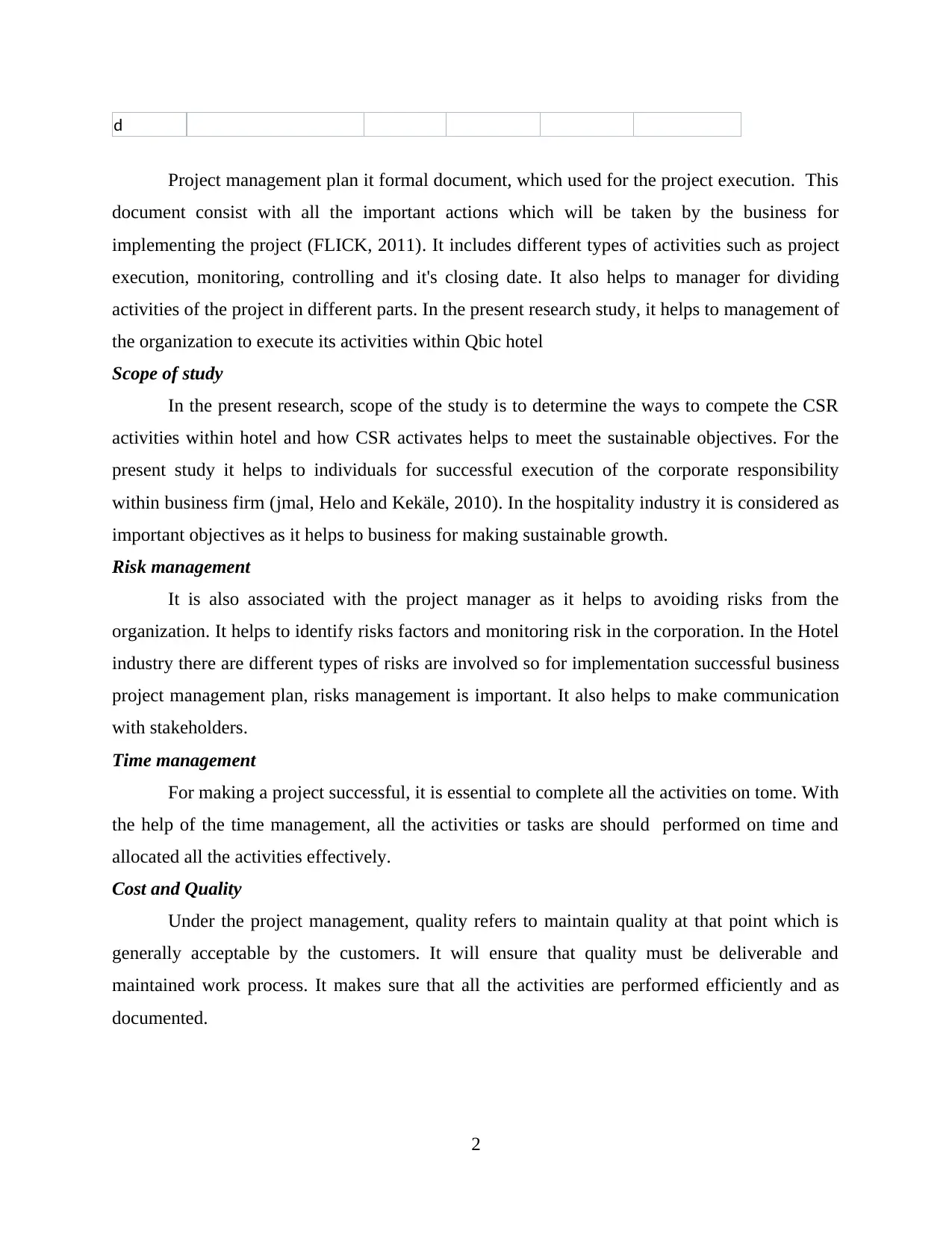
d
Project management plan it formal document, which used for the project execution. This
document consist with all the important actions which will be taken by the business for
implementing the project (FLICK, 2011). It includes different types of activities such as project
execution, monitoring, controlling and it's closing date. It also helps to manager for dividing
activities of the project in different parts. In the present research study, it helps to management of
the organization to execute its activities within Qbic hotel
Scope of study
In the present research, scope of the study is to determine the ways to compete the CSR
activities within hotel and how CSR activates helps to meet the sustainable objectives. For the
present study it helps to individuals for successful execution of the corporate responsibility
within business firm (jmal, Helo and Kekäle, 2010). In the hospitality industry it is considered as
important objectives as it helps to business for making sustainable growth.
Risk management
It is also associated with the project manager as it helps to avoiding risks from the
organization. It helps to identify risks factors and monitoring risk in the corporation. In the Hotel
industry there are different types of risks are involved so for implementation successful business
project management plan, risks management is important. It also helps to make communication
with stakeholders.
Time management
For making a project successful, it is essential to complete all the activities on tome. With
the help of the time management, all the activities or tasks are should performed on time and
allocated all the activities effectively.
Cost and Quality
Under the project management, quality refers to maintain quality at that point which is
generally acceptable by the customers. It will ensure that quality must be deliverable and
maintained work process. It makes sure that all the activities are performed efficiently and as
documented.
2
Project management plan it formal document, which used for the project execution. This
document consist with all the important actions which will be taken by the business for
implementing the project (FLICK, 2011). It includes different types of activities such as project
execution, monitoring, controlling and it's closing date. It also helps to manager for dividing
activities of the project in different parts. In the present research study, it helps to management of
the organization to execute its activities within Qbic hotel
Scope of study
In the present research, scope of the study is to determine the ways to compete the CSR
activities within hotel and how CSR activates helps to meet the sustainable objectives. For the
present study it helps to individuals for successful execution of the corporate responsibility
within business firm (jmal, Helo and Kekäle, 2010). In the hospitality industry it is considered as
important objectives as it helps to business for making sustainable growth.
Risk management
It is also associated with the project manager as it helps to avoiding risks from the
organization. It helps to identify risks factors and monitoring risk in the corporation. In the Hotel
industry there are different types of risks are involved so for implementation successful business
project management plan, risks management is important. It also helps to make communication
with stakeholders.
Time management
For making a project successful, it is essential to complete all the activities on tome. With
the help of the time management, all the activities or tasks are should performed on time and
allocated all the activities effectively.
Cost and Quality
Under the project management, quality refers to maintain quality at that point which is
generally acceptable by the customers. It will ensure that quality must be deliverable and
maintained work process. It makes sure that all the activities are performed efficiently and as
documented.
2
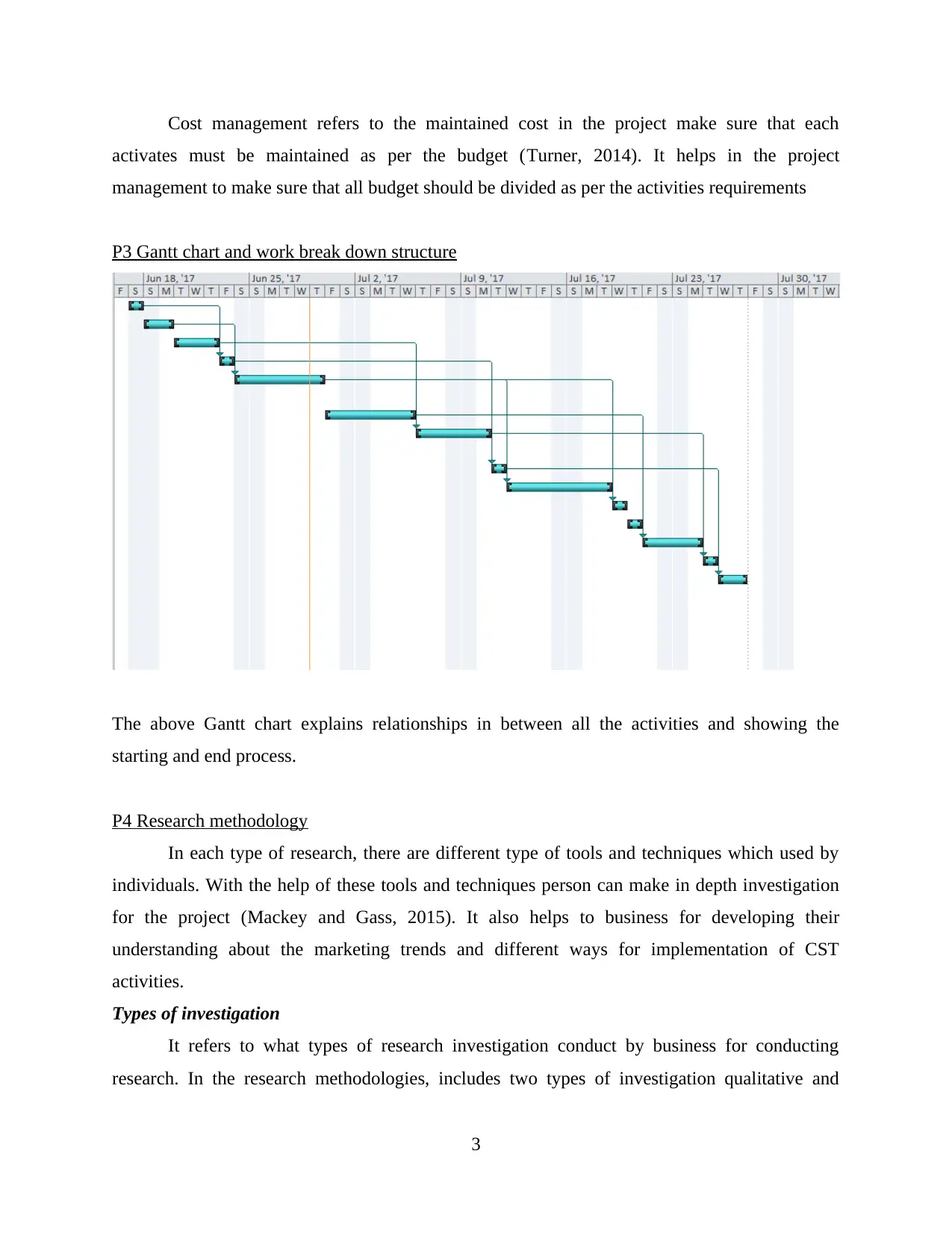
Cost management refers to the maintained cost in the project make sure that each
activates must be maintained as per the budget (Turner, 2014). It helps in the project
management to make sure that all budget should be divided as per the activities requirements
P3 Gantt chart and work break down structure
The above Gantt chart explains relationships in between all the activities and showing the
starting and end process.
P4 Research methodology
In each type of research, there are different type of tools and techniques which used by
individuals. With the help of these tools and techniques person can make in depth investigation
for the project (Mackey and Gass, 2015). It also helps to business for developing their
understanding about the marketing trends and different ways for implementation of CST
activities.
Types of investigation
It refers to what types of research investigation conduct by business for conducting
research. In the research methodologies, includes two types of investigation qualitative and
3
activates must be maintained as per the budget (Turner, 2014). It helps in the project
management to make sure that all budget should be divided as per the activities requirements
P3 Gantt chart and work break down structure
The above Gantt chart explains relationships in between all the activities and showing the
starting and end process.
P4 Research methodology
In each type of research, there are different type of tools and techniques which used by
individuals. With the help of these tools and techniques person can make in depth investigation
for the project (Mackey and Gass, 2015). It also helps to business for developing their
understanding about the marketing trends and different ways for implementation of CST
activities.
Types of investigation
It refers to what types of research investigation conduct by business for conducting
research. In the research methodologies, includes two types of investigation qualitative and
3
⊘ This is a preview!⊘
Do you want full access?
Subscribe today to unlock all pages.

Trusted by 1+ million students worldwide
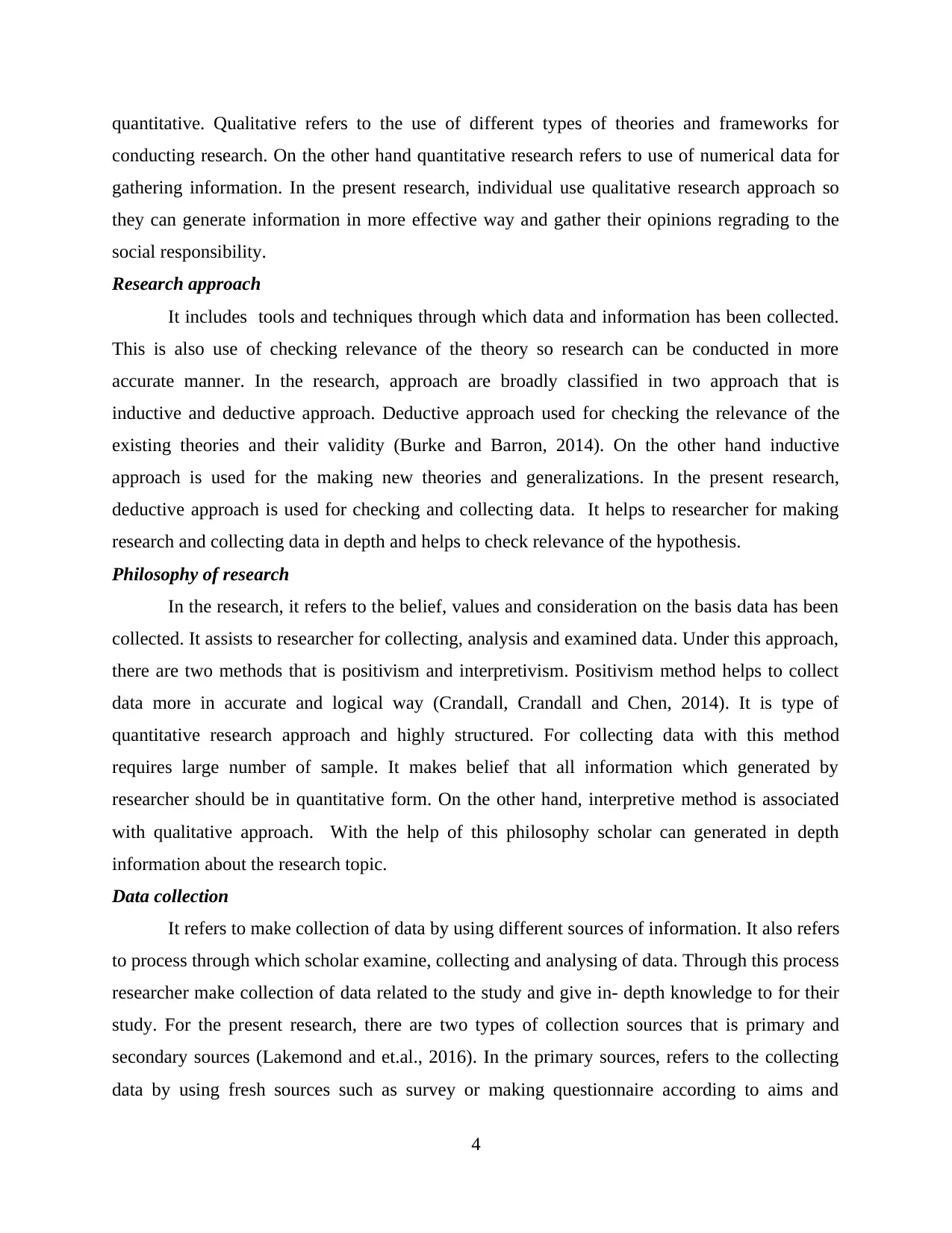
quantitative. Qualitative refers to the use of different types of theories and frameworks for
conducting research. On the other hand quantitative research refers to use of numerical data for
gathering information. In the present research, individual use qualitative research approach so
they can generate information in more effective way and gather their opinions regrading to the
social responsibility.
Research approach
It includes tools and techniques through which data and information has been collected.
This is also use of checking relevance of the theory so research can be conducted in more
accurate manner. In the research, approach are broadly classified in two approach that is
inductive and deductive approach. Deductive approach used for checking the relevance of the
existing theories and their validity (Burke and Barron, 2014). On the other hand inductive
approach is used for the making new theories and generalizations. In the present research,
deductive approach is used for checking and collecting data. It helps to researcher for making
research and collecting data in depth and helps to check relevance of the hypothesis.
Philosophy of research
In the research, it refers to the belief, values and consideration on the basis data has been
collected. It assists to researcher for collecting, analysis and examined data. Under this approach,
there are two methods that is positivism and interpretivism. Positivism method helps to collect
data more in accurate and logical way (Crandall, Crandall and Chen, 2014). It is type of
quantitative research approach and highly structured. For collecting data with this method
requires large number of sample. It makes belief that all information which generated by
researcher should be in quantitative form. On the other hand, interpretive method is associated
with qualitative approach. With the help of this philosophy scholar can generated in depth
information about the research topic.
Data collection
It refers to make collection of data by using different sources of information. It also refers
to process through which scholar examine, collecting and analysing of data. Through this process
researcher make collection of data related to the study and give in- depth knowledge to for their
study. For the present research, there are two types of collection sources that is primary and
secondary sources (Lakemond and et.al., 2016). In the primary sources, refers to the collecting
data by using fresh sources such as survey or making questionnaire according to aims and
4
conducting research. On the other hand quantitative research refers to use of numerical data for
gathering information. In the present research, individual use qualitative research approach so
they can generate information in more effective way and gather their opinions regrading to the
social responsibility.
Research approach
It includes tools and techniques through which data and information has been collected.
This is also use of checking relevance of the theory so research can be conducted in more
accurate manner. In the research, approach are broadly classified in two approach that is
inductive and deductive approach. Deductive approach used for checking the relevance of the
existing theories and their validity (Burke and Barron, 2014). On the other hand inductive
approach is used for the making new theories and generalizations. In the present research,
deductive approach is used for checking and collecting data. It helps to researcher for making
research and collecting data in depth and helps to check relevance of the hypothesis.
Philosophy of research
In the research, it refers to the belief, values and consideration on the basis data has been
collected. It assists to researcher for collecting, analysis and examined data. Under this approach,
there are two methods that is positivism and interpretivism. Positivism method helps to collect
data more in accurate and logical way (Crandall, Crandall and Chen, 2014). It is type of
quantitative research approach and highly structured. For collecting data with this method
requires large number of sample. It makes belief that all information which generated by
researcher should be in quantitative form. On the other hand, interpretive method is associated
with qualitative approach. With the help of this philosophy scholar can generated in depth
information about the research topic.
Data collection
It refers to make collection of data by using different sources of information. It also refers
to process through which scholar examine, collecting and analysing of data. Through this process
researcher make collection of data related to the study and give in- depth knowledge to for their
study. For the present research, there are two types of collection sources that is primary and
secondary sources (Lakemond and et.al., 2016). In the primary sources, refers to the collecting
data by using fresh sources such as survey or making questionnaire according to aims and
4
Paraphrase This Document
Need a fresh take? Get an instant paraphrase of this document with our AI Paraphraser
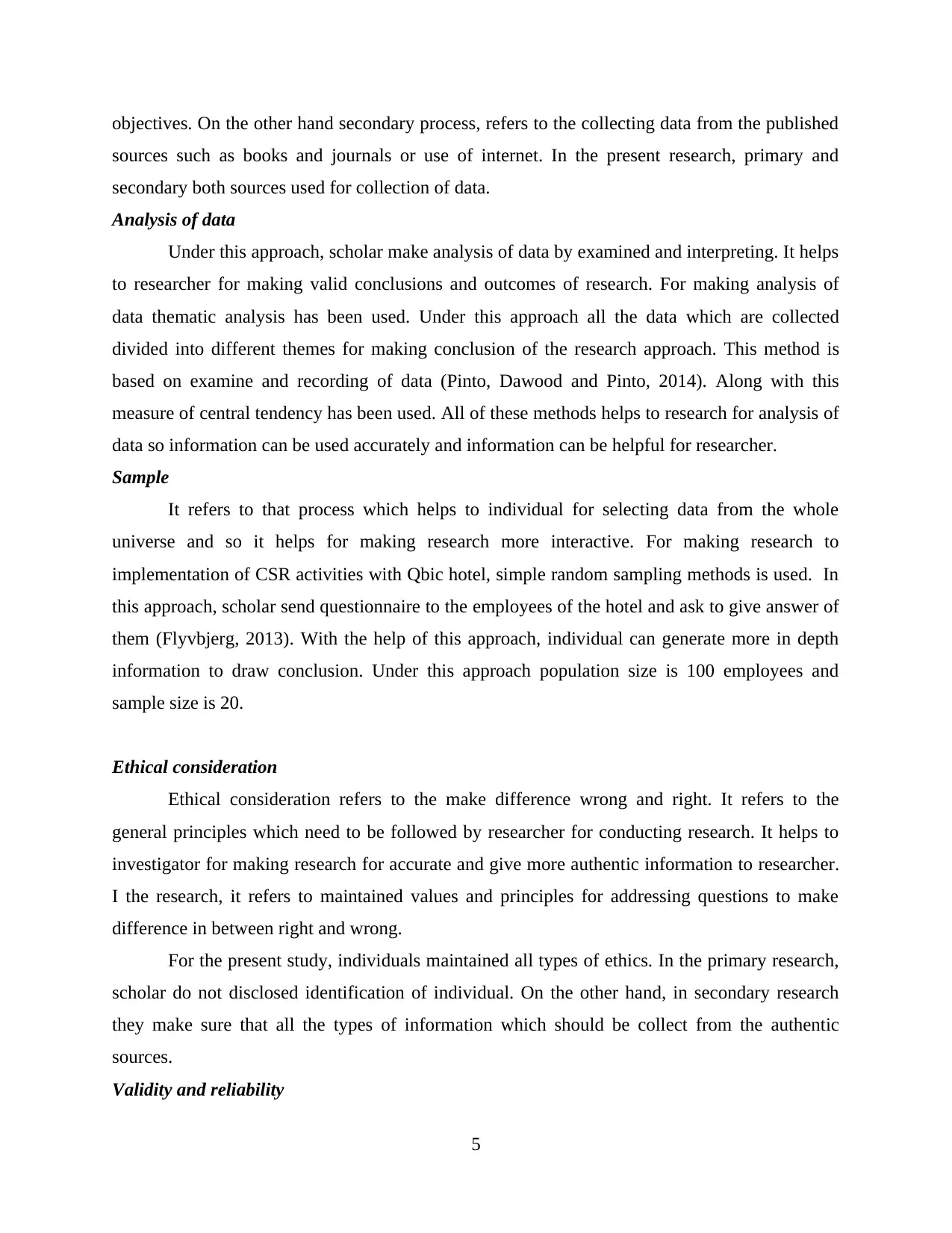
objectives. On the other hand secondary process, refers to the collecting data from the published
sources such as books and journals or use of internet. In the present research, primary and
secondary both sources used for collection of data.
Analysis of data
Under this approach, scholar make analysis of data by examined and interpreting. It helps
to researcher for making valid conclusions and outcomes of research. For making analysis of
data thematic analysis has been used. Under this approach all the data which are collected
divided into different themes for making conclusion of the research approach. This method is
based on examine and recording of data (Pinto, Dawood and Pinto, 2014). Along with this
measure of central tendency has been used. All of these methods helps to research for analysis of
data so information can be used accurately and information can be helpful for researcher.
Sample
It refers to that process which helps to individual for selecting data from the whole
universe and so it helps for making research more interactive. For making research to
implementation of CSR activities with Qbic hotel, simple random sampling methods is used. In
this approach, scholar send questionnaire to the employees of the hotel and ask to give answer of
them (Flyvbjerg, 2013). With the help of this approach, individual can generate more in depth
information to draw conclusion. Under this approach population size is 100 employees and
sample size is 20.
Ethical consideration
Ethical consideration refers to the make difference wrong and right. It refers to the
general principles which need to be followed by researcher for conducting research. It helps to
investigator for making research for accurate and give more authentic information to researcher.
I the research, it refers to maintained values and principles for addressing questions to make
difference in between right and wrong.
For the present study, individuals maintained all types of ethics. In the primary research,
scholar do not disclosed identification of individual. On the other hand, in secondary research
they make sure that all the types of information which should be collect from the authentic
sources.
Validity and reliability
5
sources such as books and journals or use of internet. In the present research, primary and
secondary both sources used for collection of data.
Analysis of data
Under this approach, scholar make analysis of data by examined and interpreting. It helps
to researcher for making valid conclusions and outcomes of research. For making analysis of
data thematic analysis has been used. Under this approach all the data which are collected
divided into different themes for making conclusion of the research approach. This method is
based on examine and recording of data (Pinto, Dawood and Pinto, 2014). Along with this
measure of central tendency has been used. All of these methods helps to research for analysis of
data so information can be used accurately and information can be helpful for researcher.
Sample
It refers to that process which helps to individual for selecting data from the whole
universe and so it helps for making research more interactive. For making research to
implementation of CSR activities with Qbic hotel, simple random sampling methods is used. In
this approach, scholar send questionnaire to the employees of the hotel and ask to give answer of
them (Flyvbjerg, 2013). With the help of this approach, individual can generate more in depth
information to draw conclusion. Under this approach population size is 100 employees and
sample size is 20.
Ethical consideration
Ethical consideration refers to the make difference wrong and right. It refers to the
general principles which need to be followed by researcher for conducting research. It helps to
investigator for making research for accurate and give more authentic information to researcher.
I the research, it refers to maintained values and principles for addressing questions to make
difference in between right and wrong.
For the present study, individuals maintained all types of ethics. In the primary research,
scholar do not disclosed identification of individual. On the other hand, in secondary research
they make sure that all the types of information which should be collect from the authentic
sources.
Validity and reliability
5
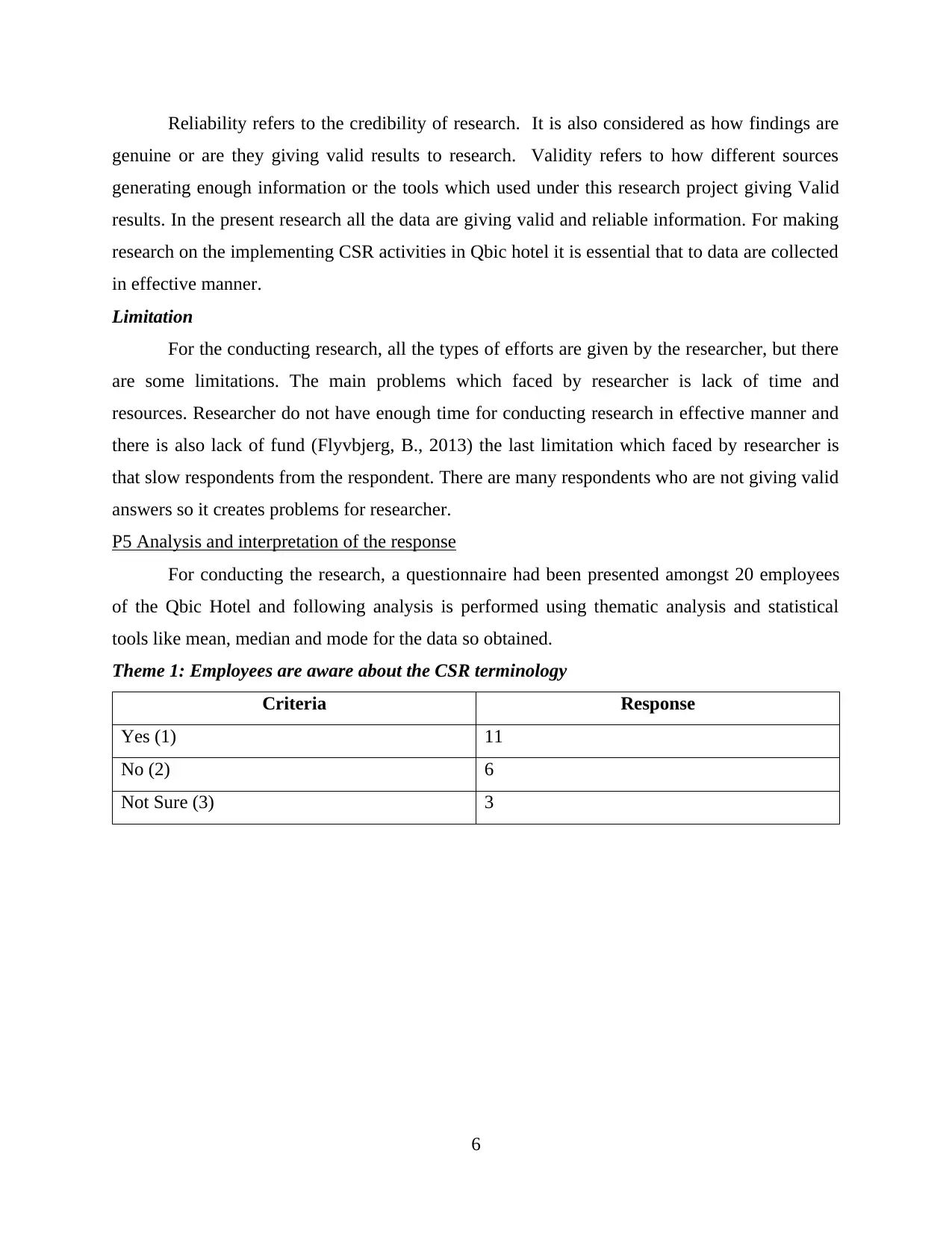
Reliability refers to the credibility of research. It is also considered as how findings are
genuine or are they giving valid results to research. Validity refers to how different sources
generating enough information or the tools which used under this research project giving Valid
results. In the present research all the data are giving valid and reliable information. For making
research on the implementing CSR activities in Qbic hotel it is essential that to data are collected
in effective manner.
Limitation
For the conducting research, all the types of efforts are given by the researcher, but there
are some limitations. The main problems which faced by researcher is lack of time and
resources. Researcher do not have enough time for conducting research in effective manner and
there is also lack of fund (Flyvbjerg, B., 2013) the last limitation which faced by researcher is
that slow respondents from the respondent. There are many respondents who are not giving valid
answers so it creates problems for researcher.
P5 Analysis and interpretation of the response
For conducting the research, a questionnaire had been presented amongst 20 employees
of the Qbic Hotel and following analysis is performed using thematic analysis and statistical
tools like mean, median and mode for the data so obtained.
Theme 1: Employees are aware about the CSR terminology
Criteria Response
Yes (1) 11
No (2) 6
Not Sure (3) 3
6
genuine or are they giving valid results to research. Validity refers to how different sources
generating enough information or the tools which used under this research project giving Valid
results. In the present research all the data are giving valid and reliable information. For making
research on the implementing CSR activities in Qbic hotel it is essential that to data are collected
in effective manner.
Limitation
For the conducting research, all the types of efforts are given by the researcher, but there
are some limitations. The main problems which faced by researcher is lack of time and
resources. Researcher do not have enough time for conducting research in effective manner and
there is also lack of fund (Flyvbjerg, B., 2013) the last limitation which faced by researcher is
that slow respondents from the respondent. There are many respondents who are not giving valid
answers so it creates problems for researcher.
P5 Analysis and interpretation of the response
For conducting the research, a questionnaire had been presented amongst 20 employees
of the Qbic Hotel and following analysis is performed using thematic analysis and statistical
tools like mean, median and mode for the data so obtained.
Theme 1: Employees are aware about the CSR terminology
Criteria Response
Yes (1) 11
No (2) 6
Not Sure (3) 3
6
⊘ This is a preview!⊘
Do you want full access?
Subscribe today to unlock all pages.

Trusted by 1+ million students worldwide
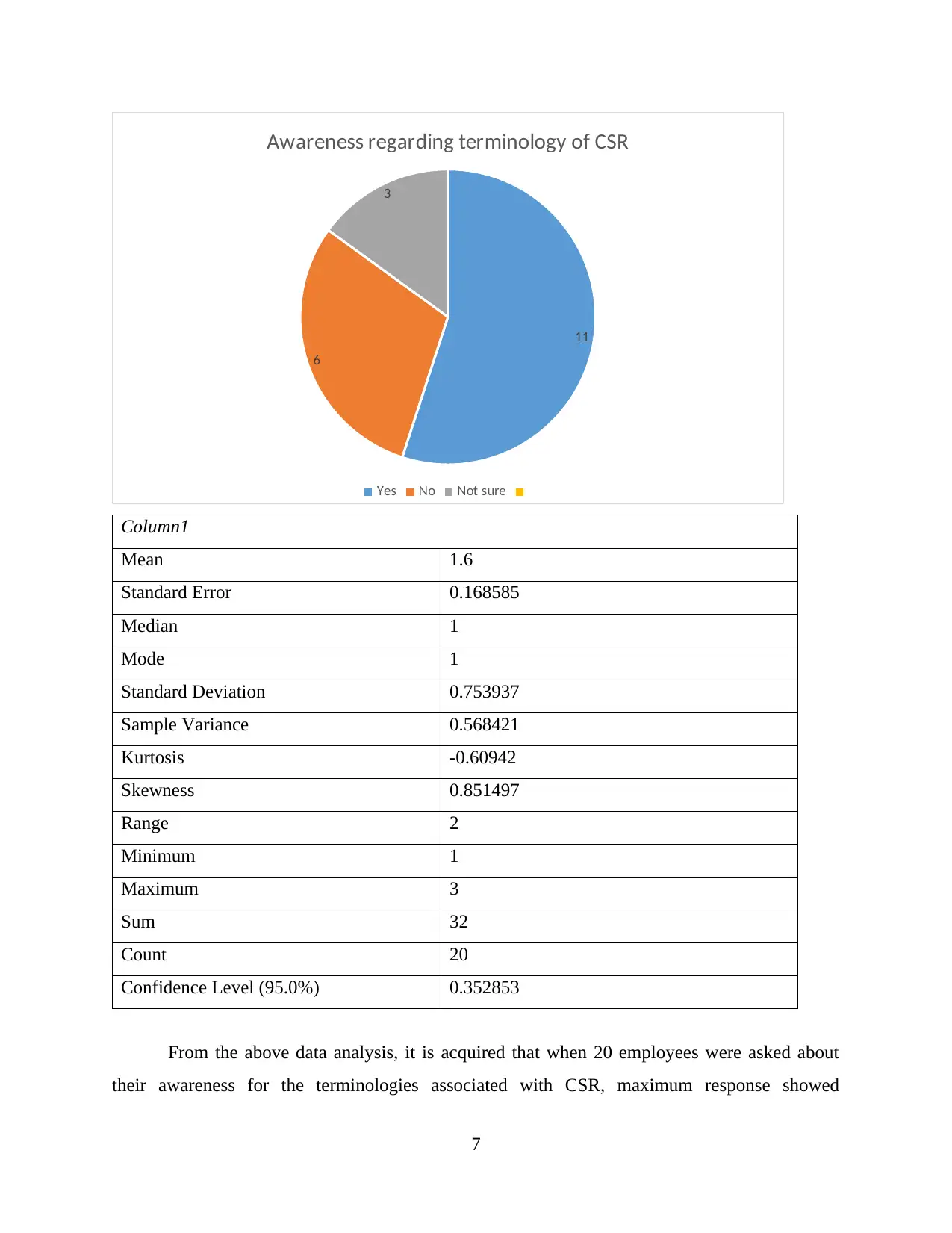
11
6
3
Awareness regarding terminology of CSR
Yes No Not sure
Column1
Mean 1.6
Standard Error 0.168585
Median 1
Mode 1
Standard Deviation 0.753937
Sample Variance 0.568421
Kurtosis -0.60942
Skewness 0.851497
Range 2
Minimum 1
Maximum 3
Sum 32
Count 20
Confidence Level (95.0%) 0.352853
From the above data analysis, it is acquired that when 20 employees were asked about
their awareness for the terminologies associated with CSR, maximum response showed
7
6
3
Awareness regarding terminology of CSR
Yes No Not sure
Column1
Mean 1.6
Standard Error 0.168585
Median 1
Mode 1
Standard Deviation 0.753937
Sample Variance 0.568421
Kurtosis -0.60942
Skewness 0.851497
Range 2
Minimum 1
Maximum 3
Sum 32
Count 20
Confidence Level (95.0%) 0.352853
From the above data analysis, it is acquired that when 20 employees were asked about
their awareness for the terminologies associated with CSR, maximum response showed
7
Paraphrase This Document
Need a fresh take? Get an instant paraphrase of this document with our AI Paraphraser
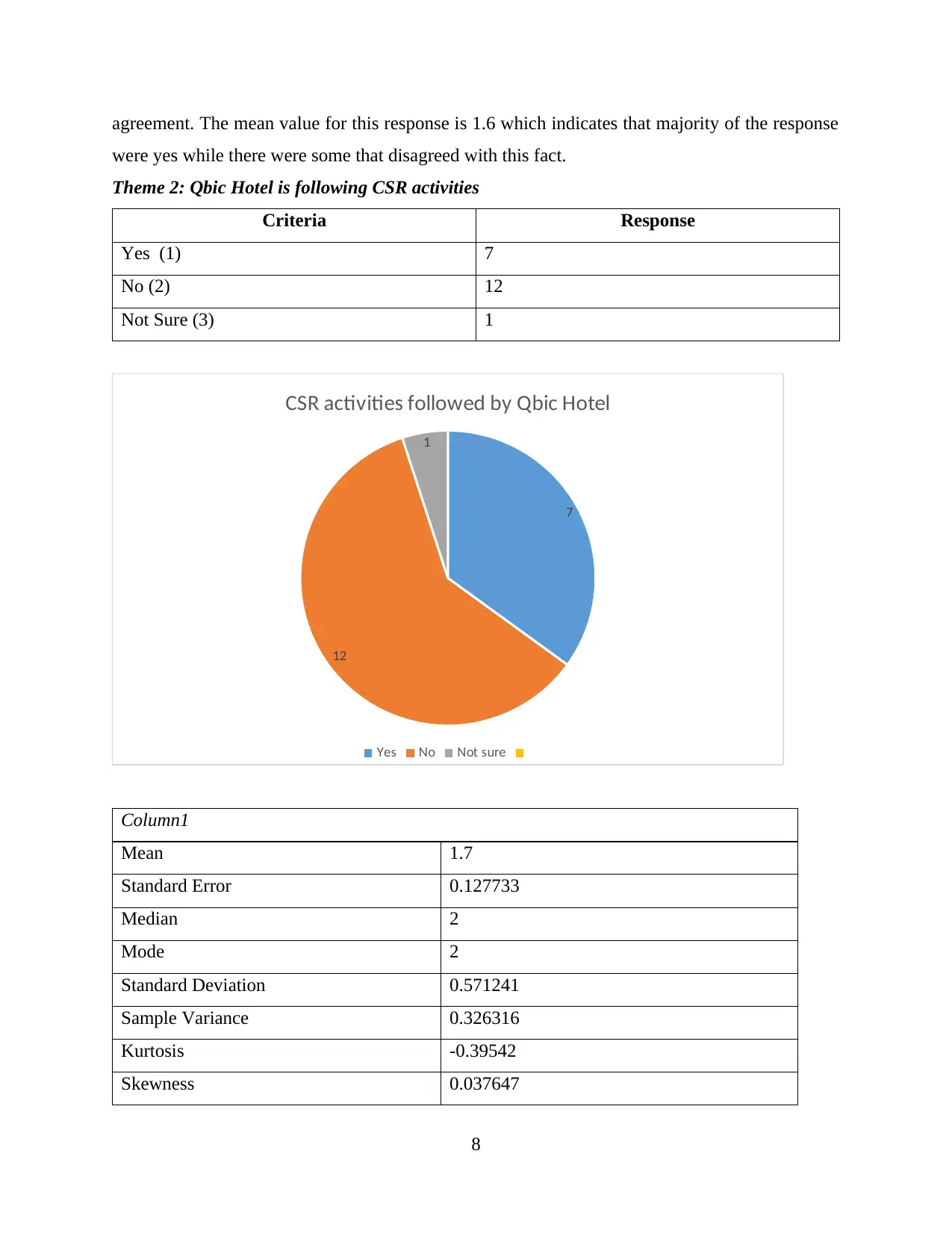
agreement. The mean value for this response is 1.6 which indicates that majority of the response
were yes while there were some that disagreed with this fact.
Theme 2: Qbic Hotel is following CSR activities
Criteria Response
Yes (1) 7
No (2) 12
Not Sure (3) 1
7
12
1
CSR activities followed by Qbic Hotel
Yes No Not sure
Column1
Mean 1.7
Standard Error 0.127733
Median 2
Mode 2
Standard Deviation 0.571241
Sample Variance 0.326316
Kurtosis -0.39542
Skewness 0.037647
8
were yes while there were some that disagreed with this fact.
Theme 2: Qbic Hotel is following CSR activities
Criteria Response
Yes (1) 7
No (2) 12
Not Sure (3) 1
7
12
1
CSR activities followed by Qbic Hotel
Yes No Not sure
Column1
Mean 1.7
Standard Error 0.127733
Median 2
Mode 2
Standard Deviation 0.571241
Sample Variance 0.326316
Kurtosis -0.39542
Skewness 0.037647
8
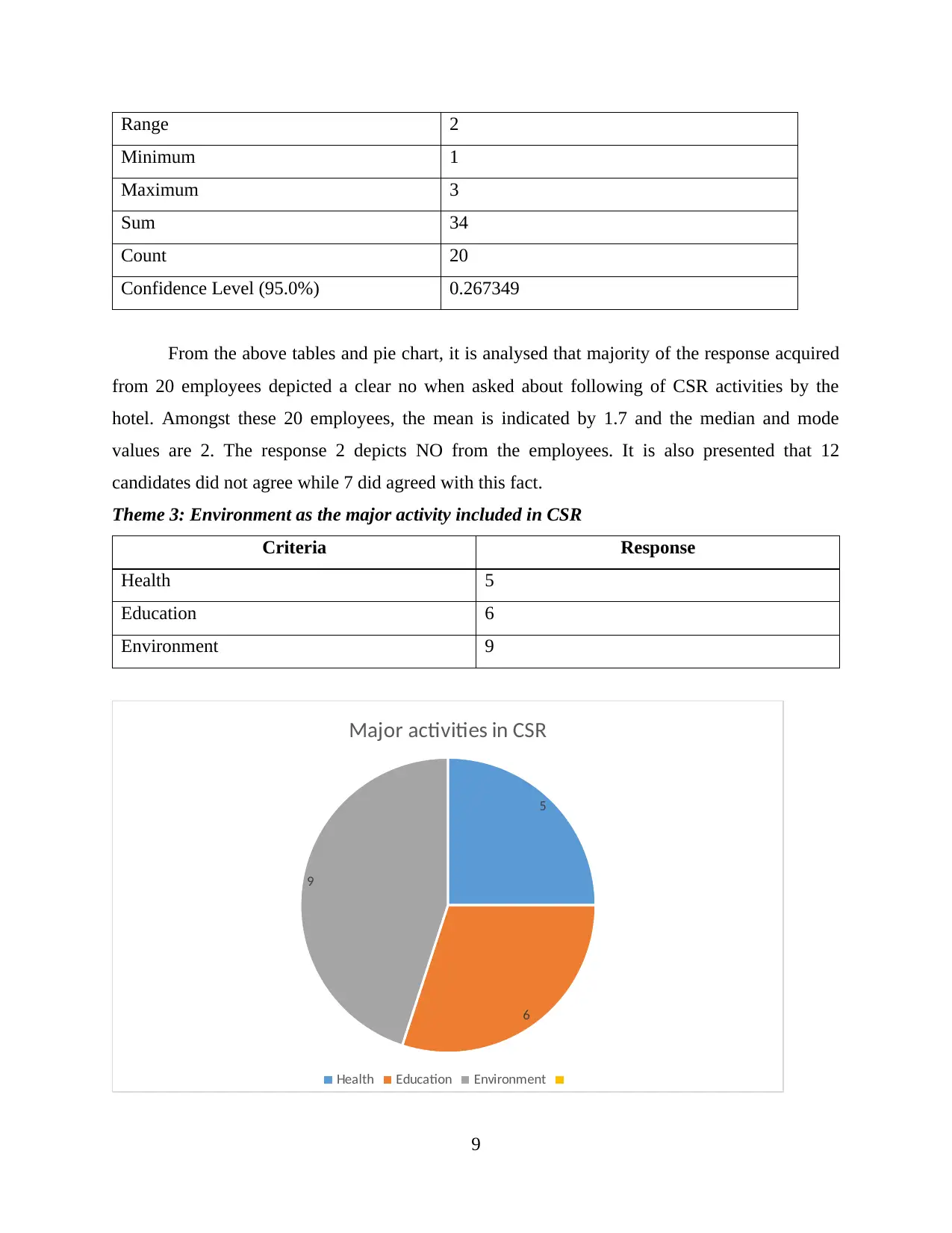
Range 2
Minimum 1
Maximum 3
Sum 34
Count 20
Confidence Level (95.0%) 0.267349
From the above tables and pie chart, it is analysed that majority of the response acquired
from 20 employees depicted a clear no when asked about following of CSR activities by the
hotel. Amongst these 20 employees, the mean is indicated by 1.7 and the median and mode
values are 2. The response 2 depicts NO from the employees. It is also presented that 12
candidates did not agree while 7 did agreed with this fact.
Theme 3: Environment as the major activity included in CSR
Criteria Response
Health 5
Education 6
Environment 9
5
6
9
Major activities in CSR
Health Education Environment
9
Minimum 1
Maximum 3
Sum 34
Count 20
Confidence Level (95.0%) 0.267349
From the above tables and pie chart, it is analysed that majority of the response acquired
from 20 employees depicted a clear no when asked about following of CSR activities by the
hotel. Amongst these 20 employees, the mean is indicated by 1.7 and the median and mode
values are 2. The response 2 depicts NO from the employees. It is also presented that 12
candidates did not agree while 7 did agreed with this fact.
Theme 3: Environment as the major activity included in CSR
Criteria Response
Health 5
Education 6
Environment 9
5
6
9
Major activities in CSR
Health Education Environment
9
⊘ This is a preview!⊘
Do you want full access?
Subscribe today to unlock all pages.

Trusted by 1+ million students worldwide
1 out of 25
Related Documents
Your All-in-One AI-Powered Toolkit for Academic Success.
+13062052269
info@desklib.com
Available 24*7 on WhatsApp / Email
![[object Object]](/_next/static/media/star-bottom.7253800d.svg)
Unlock your academic potential
Copyright © 2020–2025 A2Z Services. All Rights Reserved. Developed and managed by ZUCOL.





